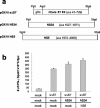Optimal induction of T-cell responses against hepatitis C virus E2 by antigen engineering in DNA immunization
- PMID: 14557645
- PMCID: PMC229347
- DOI: 10.1128/jvi.77.21.11596-11602.2003
Optimal induction of T-cell responses against hepatitis C virus E2 by antigen engineering in DNA immunization
Abstract
Although DNA immunization is a safe and efficient method for inducing cellular immune responses, it generates relatively weak and slow immune responses. Here, we investigated the effect of hepatitis C virus (HCV) antigen modifications on the induction of T-cell responses in DNA immunization. It is likely that the strength of T-cell responses has an inverse relationship with the length of the insert DNA. Interestingly, a mixture of several plasmids carrying each gene induced a higher level of T-cell responses than a single plasmid expressing a long polyprotein. Moreover, the presence of a transmembrane domain in HCV E2 resulted in stronger T-cell responses against E2 protein than its absence. Taken together, our results indicate that the tailored modifications of DNA-encoded antigens are capable of optimizing the induction of T-cell responses which is required for eliminating the cells chronically infected with highly variable viruses such as HCV and human immunodeficiency virus.
Figures





Similar articles
-
Genetic immunization of wild-type and hepatitis C virus transgenic mice reveals a hierarchy of cellular immune response and tolerance induction against hepatitis C virus structural proteins.J Virol. 2001 Dec;75(24):12121-7. doi: 10.1128/JVI.75.24.12121-12127.2001. J Virol. 2001. PMID: 11711603 Free PMC article.
-
Synergistic effect of gene-electro transfer and adjuvant cytokines in increasing the potency of hepatitis C virus genetic vaccination.J Gene Med. 2008 Sep;10(9):1048-54. doi: 10.1002/jgm.1217. J Gene Med. 2008. PMID: 18655231
-
Oral immunization with attenuated Salmonella carrying a co-expression plasmid encoding the core and E2 proteins of hepatitis C virus capable of inducing cellular immune responses and neutralizing antibodies in mice.Vaccine. 2011 May 9;29(20):3714-23. doi: 10.1016/j.vaccine.2011.02.083. Epub 2011 Mar 9. Vaccine. 2011. PMID: 21396407
-
Gene vaccination for hepatitis C.Springer Semin Immunopathol. 1997;19(2):211-21. doi: 10.1007/BF00870269. Springer Semin Immunopathol. 1997. PMID: 9406347 Review. No abstract available.
-
Prospects for prophylactic and therapeutic vaccines against the hepatitis C viruses.Immunol Rev. 2011 Jan;239(1):99-108. doi: 10.1111/j.1600-065X.2010.00977.x. Immunol Rev. 2011. PMID: 21198667 Review.
Cited by
-
Development of hepatitis C virus vaccine using hepatitis B core antigen as immuno-carrier.World J Gastroenterol. 2006 Dec 28;12(48):7774-8. doi: 10.3748/wjg.v12.i48.7774. World J Gastroenterol. 2006. PMID: 17203519 Free PMC article.
-
Evidence for protection against chronic hepatitis C virus infection in chimpanzees by immunization with replicating recombinant vaccinia virus.J Virol. 2008 Nov;82(21):10896-905. doi: 10.1128/JVI.01179-08. Epub 2008 Aug 27. J Virol. 2008. PMID: 18753204 Free PMC article.
-
Codelivery of IL-7 Augments Multigenic HCV DNA Vaccine-induced Antibody as well as Broad T Cell Responses in Cynomolgus Monkeys.Immune Netw. 2010 Dec;10(6):198-205. doi: 10.4110/in.2010.10.6.198. Epub 2010 Dec 31. Immune Netw. 2010. PMID: 21286380 Free PMC article.
-
Therapeutic immunization for HIV.Springer Semin Immunopathol. 2006 Nov;28(3):221-30. doi: 10.1007/s00281-006-0029-0. Epub 2006 Oct 10. Springer Semin Immunopathol. 2006. PMID: 17031650 Review.
-
Molecular characterization and clinical epidemiology of HCV in District Dir (Lower), Pakistan.Virusdisease. 2018 Sep;29(3):369-374. doi: 10.1007/s13337-018-0457-1. Epub 2018 May 17. Virusdisease. 2018. PMID: 30159373 Free PMC article.
References
-
- Berzofsky, J. A., J. D. Ahlers, and I. M. Belyakov. 2001. Strategies for designing and optimizing new generation vaccines. Nat. Rev. Immunol. 1:209-219. - PubMed
-
- Boyle, J. S., C. Koniaras, and A. M. Lew. 1997. Influence of cellular location of expressed antigen on the efficacy of DNA vaccination: cytotoxic T lymphocyte and antibody responses are suboptimal when antigen is cytoplasmic after intramuscular DNA immunization. Int. Immunol. 9:1897-1906. - PubMed
-
- Caley, I. J., M. R. Betts, N. L. Davis, R. Swanstrom, J. A. Frelinger, and R. E. Johnston. 1999. Venezuelan equine encephalitis virus vectors expressing HIV-1 proteins: vector design strategies for improved vaccine efficacy. Vaccine 17:3124-3135. - PubMed
-
- Chastain, M., A. J. Simon, K. A. Soper, D. J. Holder, D. L. Montgomery, S. L. Sagar, D. R. Casimiro, and C. R. Middaugh. 2001. Antigen levels and antibody titers after DNA vaccination. J. Pharm. Sci. 90:474-484. - PubMed
Publication types
MeSH terms
Substances
LinkOut - more resources
Full Text Sources
Molecular Biology Databases

